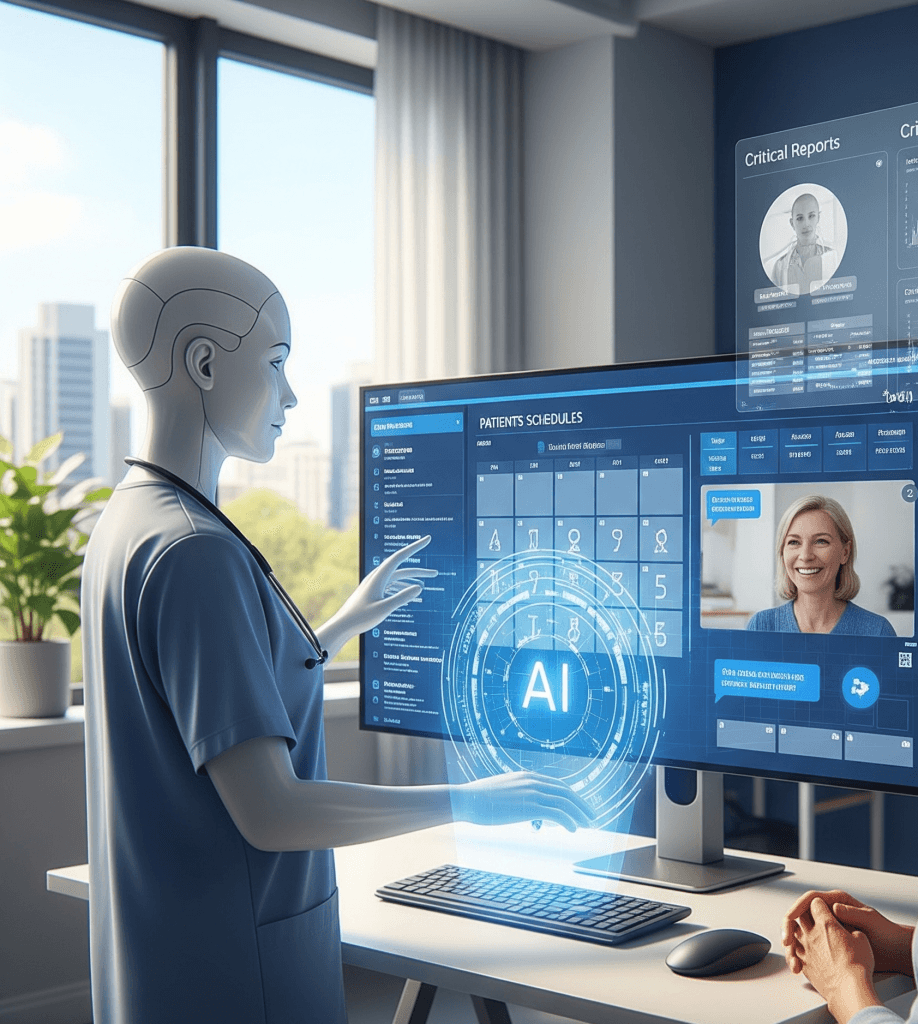
Introduction: A Healthcare Revolution Driven by AI
The healthcare industry is undergoing a profound transformation—and at the heart of this evolution is artificial intelligence. Among the most practical and widely adopted innovations is health assistant, especially in the form of virtual tools designed to support both patients and healthcare providers with real-time, automated assistance.
From scheduling appointments to managing chronic conditions, these intelligent assistants are changing the way healthcare is delivered, accessed, and experienced. Unlike traditional customer service bots, VHAs are trained in medical contexts. They can answer health-related questions, guide patients through pre-visit workflows, offer medication reminders, and even provide emotional support.
According to recent industry reports, the virtual assistant for healthcare market is growing rapidly-driven by rising patient expectations, workforce shortages, and the need for operational efficiency. Hospitals, clinics, telehealth providers, and startups alike are turning to VHAs as a scalable, cost-effective solution for improving care delivery.
In this blog, we’ll explore what virtual health assistant are, how they work, where they’re being used, and what they mean for the future of healthcare.
What Is a Health Assistant in the Virtual World?
A Virtual Health Assistant (VHA) is an AI-powered digital assistant built specifically for healthcare environments. It supports both patients and providers by automating routine tasks, delivering real-time assistance, and offering 24/7 accessibility through chat, voice, or mobile interfaces.
A combination of advanced technologies powers VHAs , including:
- Natural Language Processing (NLP) – to understand and respond to patient queries conversationally
- Machine Learning – to improve over time based on user interactions
- Data Analytics – to deliver personalized insights and recommendations
- Remote Monitoring Capabilities – to track patient vitals and symptoms when integrated with wearables or medical devices
Unlike general-purpose virtual assistants, VHAs are trained for healthcare-specific tasks such as:
- Scheduling appointments
- Sending medication reminders
- Providing condition-specific guidance and education
What sets VHAs apart is their contextual intelligence—they can adapt conversations based on patient history, preferences, or real-time inputs. As a result, they serve as a bridge between patients and healthcare providers, improving accessibility, personalization, and overall care efficiency.
Top Use Cases of Virtual Health Assistants in Modern Healthcare
Virtual Assistants for Healthcare (VHAs) are no longer just simple bots-they are emerging as essential tools in care delivery, patient engagement, and healthcare navigation. Below are key use cases where VHAs are making a real-world impact.
1. Intelligent Appointment Scheduling and Pre-Triage
VHAs simplify the appointment process by managing bookings, confirmations, and cancellations across multiple platforms. They reduce patient friction and administrative workload by operating 24/7 without human intervention. Advanced systems perform pre-visit symptom checks and guide patients to the appropriate provider or department. This not only streamlines clinical workflows but also improves access to care, ensuring timely and appropriate patient routing.
2. Personalized Medication Reminders and Adherence Monitoring
Medication non-adherence remains a major healthcare challenge. Virtual Assistants for Healthcare address this by sending timely, context-aware reminders, including dosage instructions and refill alerts. Patients can also log side effects or missed doses, triggering follow-up from care teams if needed. By supporting consistent medication behavior, VHAs enhance treatment effectiveness and reduce complications, especially for patients with chronic conditions.
3. Chronic Disease Management and Remote Monitoring
For patients managing long-term illnesses, Virtual Assistants for Healthcare offer ongoing support by tracking vital signs and symptoms. They integrate with wearable devices or accept manual inputs and monitor metrics like blood pressure, glucose levels, or oxygen saturation. When values go beyond safe thresholds, the system sends alerts directly to clinicians. This allows for proactive care, reducing emergency visits and improving patient confidence in self-management.
4. Mental Health Support and Behavioral Coaching
Access to mental health care remains limited for many due to stigma, cost, or availability. VHAs offer a safe, always-available space for emotional support, guided self-care, and even structured therapy modules like cognitive behavioral therapy. They can perform mood tracking, check-ins, and escalate when necessary. This makes mental health support more accessible and less intimidating, especially for younger patients or those in underserved areas.
5. Health Navigation, Education, and Self-Service Assistance
Patients often struggle to navigate healthcare systems. VHAs help by instantly answering FAQs related to insurance, billing, appointment prep, and more. They can also direct users to the nearest available facilities or services, using GPS or integrated databases. By providing immediate, accurate responses and educational content, VHAs reduce call center traffic and empower patients to take control of their health journey.
Strategic Benefits For Healthcare Organizations
For healthcare systems, virtual assistants for healthcare are not just tools of convenience; they represent a strategic shift toward smarter, more scalable, and patient-centric operations.
1. Streamlined Workflows and Staff Productivity
Administrative tasks such as appointment management, intake processing, and follow-ups take up a significant portion of healthcare staff’s time. VHAs take over these repetitive processes, allowing clinical teams to dedicate more attention to direct patient care. This leads to faster operations, reduced manual errors, and improved overall efficiency without requiring additional headcount.
2. Always-On Access and Improved Patient Retention
Patients increasingly expect healthcare to be as responsive as other digital services. Virtual assistants for healthcare meet this expectation by offering around-the-clock access to support, scheduling, and health information. This constant availability not only enhances patient satisfaction but also encourages loyalty and continued engagement within the provider’s network, particularly important in competitive or telehealth-driven markets.
3. Scalable Support Across Multiple Channels
VHAs can handle thousands of patient interactions simultaneously without a drop in quality or speed. Whether managing seasonal demand surges, handling a large patient population, or supporting remote locations, they offer reliable scalability. This allows organizations to expand service capacity without proportionally increasing operational costs or staff workload.
4. Cost Efficiency and Revenue Protection
By reducing call volumes, missed appointments, and clerical mistakes, VHAs lower operational costs while improving service reliability. They also support value-based care models by helping patients stick to care plans, manage chronic conditions effectively, and avoid costly readmissions. These efficiencies directly help protect revenue and improve care economics.
5. Enhanced Digital Experience and Reputation
VHAs offer patients a seamless, responsive, and often personalized digital experience. From conversational interfaces to tailored health insights, they elevate the standard of digital engagement. As patients increasingly evaluate providers based on online convenience and service quality, VHAs contribute significantly to building trust and reinforcing the organization’s brand reputation.
Real-Life Examples of AI Virtual Health Assistants in Action
Virtual health assistants are already making a tangible impact in real-world healthcare settings. From global health organizations to hospital networks and startups, many are leveraging AI to improve patient access, engagement, and efficiency.
- Mayo Clinic – Symptom Checker & Patient Guidance
Mayo Clinic has integrated an AI-powered virtual assistant on its website to help patients check symptoms, get condition-specific information, and find appropriate care. The assistant uses natural language processing (NLP) to understand user input and deliver reliable, medically reviewed content—helping patients make informed decisions before visiting a doctor. - WHO’s COVID-19 Health Bot (on WhatsApp & Facebook)
During the COVID-19 pandemic, the World Health Organization launched a multilingual chatbot on WhatsApp and Messenger. It provided real-time updates, self-assessment tools, and vaccine guidance to millions of users—demonstrating how AI can deliver scalable, life-saving information in public health crises. - Cleveland Clinic – Appointment & Triage Assistant
Cleveland Clinic partnered with Microsoft to deploy a virtual health assistant that helps patients schedule appointments, answer FAQs, and guide them to the right care path. This reduced call center load and improved access for patients needing timely care—particularly during peak periods. - Babylon Health – Full-Service AI Health Assistant
Babylon Health, a UK-based digital health platform, offers a robust AI assistant that allows users to chat about symptoms, track health data, and receive medical advice. The platform combines AI triage with access to human doctors, making it one of the most advanced examples of hybrid AI-human care models in practice. - Ada Health – Symptom Assessment for Global Users
Ada is an AI-powered symptom checker used by over 12 million users worldwide. The app asks users about their symptoms and health history, then provides possible causes and next steps. It’s widely adopted in both high-income and developing countries, showcasing how VHAs can scale across diverse health systems.
These examples show that virtual health assistants are more than just a trend—they are a proven, practical solution to modern healthcare challenges, offering speed, accuracy, and accessibility at scale.
Health Assistant Implementation: Challenges and Ethical Considerations
While virtual health assistants offer compelling benefits, healthcare organizations must address key challenges to ensure safe, effective, and ethical adoption.
1. Data Privacy and Security
VHAs deal with sensitive patient information such as symptoms, diagnoses, and medication history. Ensuring HIPAA compliance, strong encryption, secure API connections, and strict access controls is critical. A breach can quickly erode patient trust and damage the organization’s reputation.
Moreover, as these assistants scale across platforms (mobile apps, portals, voice devices), maintaining consistent cybersecurity protocols becomes more complex.
2. AI Bias and Fairness
AI models can inherit biases from training data, potentially leading to skewed medical advice or exclusionary behavior. Without regular audits, VHAs may deliver inaccurate or unequal responses. Healthcare providers must prioritize algorithm transparency, diversity in datasets, and ongoing testing to mitigate these risks.
3. Human Oversight and Clinical Safety
While VHAs can guide, they must not replace clinical judgment. Over-reliance on AI could risk delayed diagnoses or patient confusion. Establishing clear boundaries between automated and human-led decisions is essential. VHAs should function as assistants, not authorities.
4. Workforce Integration and Change Management
Staff may view automation tools as a threat to their roles. However, VHAs are designed to support—not replace—healthcare professionals. Successful implementation depends on involving staff in the rollout, offering training, and highlighting how virtual assistants for healthcare reduce workload, not job security.
When thoughtfully deployed, VHAs enhance safety, trust, and operational maturity. But they must be built and monitored with equal attention to ethics, regulation, and empathy.
The Future of Health Assistants: What’s Next in Virtual Care?
Virtual health assistants are moving beyond basic automation to become intelligent, proactive care partners. As AI advances, VHAs will start using real-time data from wearables, EHRs, and patient inputs to detect early warning signs—like heart irregularities or glucose spikes—enabling preventive intervention before crises occur.
Future VHAs will be:
- Integrated with electronic health records, helping providers access patient data faster and automate clinical documentation.
- Multilingual and culturally adaptive, ensuring inclusive communication for diverse populations by adjusting tone, language, and literacy level.
- Emotionally intelligent, recognizing signs of distress and escalating mental health concerns with empathy and discretion.
- Essential in public health emergencies, providing real-time guidance, symptom triage, and automated outreach during pandemics or natural disasters.
With these capabilities, VHAs will help shift healthcare toward a more connected, efficient, and patient-centered model, supporting both patients and providers at scale.
Frequently Asked Questions (FAQs)
- What is a virtual health assistant?
A virtual health assistant (VHA) is an AI-powered tool that automates healthcare tasks such as appointment scheduling, patient communication, medication reminders, and health education. It operates through chat, voice, or mobile apps to support both patients and providers. - How do virtual health assistants benefit healthcare providers?
VHAs improve operational efficiency by handling repetitive tasks, reducing staff workload, and offering 24/7 patient engagement. This leads to better resource utilization, higher patient satisfaction, and more time for clinical teams to focus on care. - Are virtual health assistants safe and HIPAA-compliant?
Yes, if properly implemented. VHAs are designed to follow healthcare data security regulations like HIPAA, ensuring encrypted communication, access control, and secure handling of sensitive patient data. - Can virtual assistants replace doctors or nurses?
No. VHAs are designed to assist healthcare professionals—not replace them. They handle administrative and informational tasks, while diagnoses, treatments, and clinical decisions remain with licensed practitioners. - How can a healthcare facility start using a virtual health assistant?
Begin by identifying your specific needs—such as reducing no-shows or improving patient communication. Choose a trusted, HIPAA-compliant VHA platform, integrate it with your existing systems, train your staff, and monitor performance for continuous improvement.
Conclusion: From Idea to Intelligent Health Assistant
Virtual Health Assistants are no longer futuristic concepts—they’re becoming foundational components of modern healthcare systems. Their ability to automate routine tasks, provide 24/7 support, and assist in clinical workflows is transforming how care is delivered and experienced.
From appointment scheduling to chronic disease management, VHAs are helping healthcare providers improve efficiency, enhance patient outcomes, and increase overall satisfaction. They also enable systems to scale services, reach underserved populations, and respond to the growing need for digital-first care.
However, successful adoption goes beyond the technology itself. It requires thoughtful integration, strong data governance, and a human-centered approach. These assistants are not here to replace doctors or nurses—they are designed to empower clinicians, reduce administrative burden, and support smarter, more personalized care.
As healthcare continues to evolve, virtual assistants are poised to play an even greater role—serving as strategic partners in building a more connected, efficient, and patient-driven future.
Talk to our AI experts to explore how we can implement virtual assistants for your organization.



